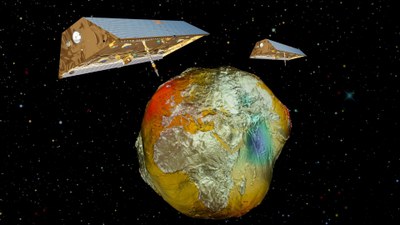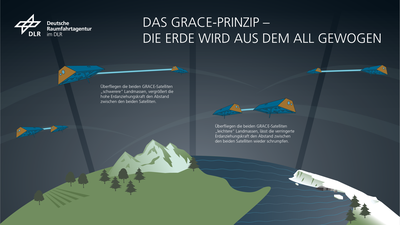Determining Earth’s weight from space
Germany has lost more than 15 billion tonnes of water over the past 20 years. To collect such data and use it to obtain an accurate picture of the global water balance, it is necessary to ‘look’ beneath Earth’s surface from space. Together with other measurement methods, data from a very special pair of satellites has been helping researchers for more than two decades. On 17 March 2002, ‘Tom’ and ‘Jerry’, the first two satellites in the Gravity Recovery and Climate Experiment (GRACE) mission, were launched by NASA and the German Aerospace Center (DLR). Twenty-two years later, the German Space Agency at DLR and NASA have extended this highly successful mission for the second time with GRACE-C, following GRACE Follow-On (GRACE-FO). The ‘C’ stands for ‘Continuity’, recognising the consistency of these environmental missions’ measurement series.
The German contribution is being implemented with funding from the Federal Ministry for Economic Affairs and Climate Action (BMWK) and the Federal Ministry of Education and Research (BMBF) with the participation of the GeoForschungsZentrum (GFZ) in Potsdam and the Max Planck Institute for Gravitational Physics (Albert Einstein Institute) in Hanover. The satellites are being built by Airbus in Friedrichshafen. Important parts of the instrument will be supplied by SpaceTech GmbH in Immenstaad. The launch is scheduled for 2028 on board a Falcon 9 rocket from the US aerospace company SpaceX. The German Space Operations Center (GSOC) at the DLR site in Oberpfaffenhofen will then take over mission control.
The centrepiece of the GRACE-C mission is the precise measurement of very small distance variations between the two satellites as they orbit Earth. The pair of satellites will measure the masses solely on the basis of their gravitational pull. To do this, the two satellites fly one behind the other at an average distance of only approximately 220 kilometres. The relative distance variations and speed of the two will be constantly and precisely measured, achieving an accuracy of 200 to 300 kilometres. An accuracy of 200 to 300 picometres is achieved – roughly the size of an atom.
Links:
German Aerospace Center (DLR)
German Space Agency at DLR
E-Mail contact-dlr@DLR.de

